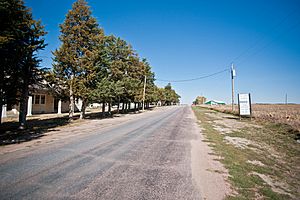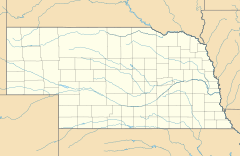St. James, Nebraska facts for kids
Quick facts for kids
St. James, Nebraska
|
|
|---|---|
 |
|
| Country | United States |
| State | Nebraska |
| County | Cedar |
| Population
(2010)
|
|
| • Total | est. 12 |
| Time zone | UTC-6 (Central (CST)) |
| • Summer (DST) | UTC-5 (CDT) |
| Area code(s) | 402 |
St. James is a small, unincorporated community in Cedar County, Nebraska, United States. It was first settled in 1856. St. James was once the very first county seat for Cedar County.
Interestingly, St. James has existed in two different places. The first spot was where Bow Creek meets the Missouri River. The second, called Old St. James, was about 1.5 miles south of the first location. Today's St. James is a bit different. It includes the St. James Marketplace, a Catholic cemetery, a bar/restaurant, and a few homes.
Contents
The Story of Old St. James
Old St. James was the second location of this community. Its story actually began at St. James Landing. This landing was where the Missouri River met Petite Arc Creek. French fur traders gave Petite Arc Creek its name. Today, it is known as Main Bow Creek.
Early Days and Founders
In 1857, some important people started the St. James-Minnesota Ferry Co. These founders included Colonel Charles C. Van and Moses H. Deming. They wanted to carry people and goods across the Missouri River. At that time, the land on the other side was Minnesota Territory.
Van and Deming had already claimed land at the Landing in 1856. The very first home there was a cave called the "Arcade." It was dug into a hillside. By July 1857, the original St. James town was planned out. Gates P. Thurston helped design the town. He hoped it would even become Nebraska's state capital!
The First Courthouse
Thurston became Cedar County's first Judge. He built a log building that was meant to be a courthouse. Cedar County was officially formed in 1857. St. James was named its county seat. However, the log building was never used as a courthouse. Instead, people used it for church services and meetings. It also served as a safe place during times of fear about Native Americans.
Life in the Early Town
By 1860, St. James had about 50 people. The federal census from that year shows what jobs people had. There was a merchant, a carpenter, and a blacksmith. An engineer, a mechanic, a minister, and a lawyer also lived there.
In the mid-1860s, a new flour mill was built. It was about 1.5 miles upstream on Bow Creek. Because of this, the original St. James Landing town moved. The new location became what we now call Old St. James. This new area grew quickly.
Old St. James eventually had many businesses. It had the mill, two hotels, and a drug store. There were also two merchandise stores and a saloon. Two banks, a lumber store, and two hardware stores were also there. The town had a blacksmith shop, two churches, and a school.
Early Settlers and Education
Henson Wiseman was one of the first permanent settlers in the St. James area. He arrived in 1857. Sadly, in 1863, some early settlers, including members of the Wiseman family, experienced difficult and dangerous times with Native Americans. Other settlers arrived in 1857. These included James Hay, O.D. Smith, and the Ferber family.
The St. James Post Office started on July 13, 1858. At first, it moved around with the postmaster. Soon, it found a permanent home in Old St. James. It closed on May 31, 1909. Mail service then came from nearby Wynot.
Private schools began in the St. James area in 1861. The first public school in Cedar County was called St. James School. It was built in 1867. This school was about 2 miles north-northwest of Old Saint James. School District 1 was officially formed there in 1873. It closed in 1953. Later, District 10 also provided public and church-based education.
Changes and Decline
In 1869, people voted to move the county seat to St. Helena. This slowed Old St. James's growth. The town also tried to get a railroad in 1876, but it didn't happen. Its population reached about 100 people in 1882.
Another attempt for a railroad happened in 1906. The Chicago, St. Paul, Minneapolis and Omaha Railroad was asked to extend its line. However, the railroad built its end point across Bow Creek. This was one mile west of Old St. James. This new spot became the town of Wynot.
Soon, many businesses and people from Old St. James moved to Wynot. Today, Old St. James is mostly a farm and a few homes. About one mile southeast of Old St. James, you can find the SS Philip and James Catholic Cemetery. The St. James Marketplace and some homes are also there. Many people from Old St. James are buried in the Wynot Public Cemetery. It is located just south of Wynot.


